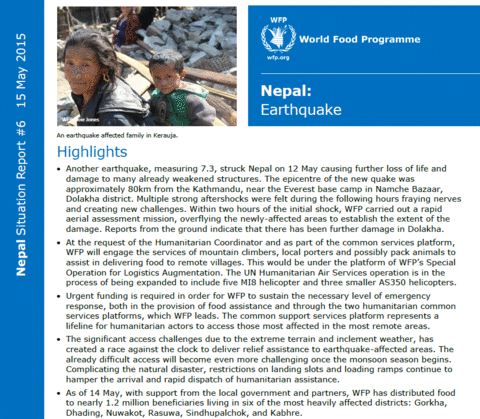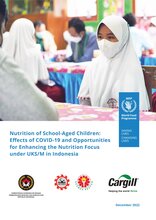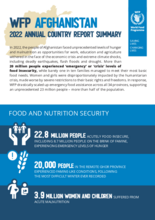
- Another earthquake, measuring 7.3, struck Nepal on 12 May causing further loss of life and damage to many already weakened structures. The epicentre of the new quake was approximately 80km from the Kathmandu, near the Everest base camp in Namche Bazaar, Dolakha district. Multiple strong aftershocks were felt during the following hours fraying nerves and creating new challenges. Within two hours of the initial shock, WFP carried out a rapid aerial assessment mission, overflying the newly-affected areas to establish the extent of the damage. Reports from the ground indicate that there has been further damage in Dolakha.
- At the request of the Humanitarian Coordinator and as part of the common services platform, WFP will engage the services of mountain climbers, local porters and possibly pack animals to assist in delivering food to remote villages. This would be under the platform of WFP’s Special Operation for Logistics Augmentation. The UN Humanitarian Air Services operation is in the process of being expanded to include five MI8 helicopter and three smaller AS350 helicopters.
- Urgent funding is required in order for WFP to sustain the necessary level of emergency response, both in the provision of food assistance and through the two humanitarian common services platforms, which WFP leads. The common support services platform represents a lifeline for humanitarian actors to access those most affected in the most remote areas.
- The significant access challenges due to the extreme terrain and inclement weather, has created a race against the clock to deliver relief assistance to earthquake-affected areas. The already difficult access will become even more challenging once the monsoon season begins. Complicating the natural disaster, restrictions on landing slots and loading ramps continue to hamper the arrival and rapid dispatch of humanitarian assistance.
- As of 14 May, with support from the local government and partners, WFP has distributed food to nearly 1.2 million beneficiaries living in six of the most heavily affected districts: Gorkha, Dhading, Nuwakot, Rasuwa, Sindhupalchok, and Kabhre.
- WFP is committed to expedite the relief operation and transition into early recovery and long-term reconstruction. WFP’s approach in the recovery phase, which is broadly supported by the Government, will leverage its extensive experience in Nepal in running community public works and rural development schemes in remote areas using conditional cash and food transfers.
- WFP is involved in the upcoming Post-Disaster Needs Assessment (PDNA), together with the World Bank, the EU and key development partners. Drawing on NeKSAP, the Nepal Government’s food security monitoring system, which is supported by WFP and funded by the EU, WFP is well positioned to provide in-depth assessment information on food security and nutrition status, market analysis, livelihoods and agriculture. Building on WFP’s long-standing presence in Nepal, WFP will be part of the core team in the Health and Nutrition sector, the Employment, Livelihoods and Social Protection sector, the Community Infrastructure sector, the Agriculture and Irrigation sector, and the Disaster Risk Management sector.
- Since launching the massive response to meet the needs of earthquake-affected people, WFP has received US$19.3 million for all three operations with US$7.8 million for the EMOP, US$6.8 million for the UNHAS Special Operation, and US$4.7 million for the Logistics and Telecommunications Special Operation.
| Document | File |
|---|---|
| Nepal Earthquake Situation Report #6, 15 May 2015 |
PDF | 480.4 KB
Download
|


